In the ever-evolving world of interior design, few statement pieces rival the dramatic impact of a Skull Dining Table. Straddling the line between avant-garde artistry and functional furniture, these tables transform ordinary dining rooms into immersive stages for conversation and intrigue. Whether you’re hosting an intimate dinner party or simply enjoying a quiet family meal, a skull-inspired table instantly elevates the ambiance, lending a sense of gothic chic that’s equal parts edgy and sophisticated.
Far from mere macabre novelty, the Skull Dining Table represents a fusion of craftsmanship, material innovation, and design philosophy. From intricately carved wooden bases to gleaming resin surfaces, these tables are built to withstand daily use while serving as focal points in any décor scheme. This article explores the allure of the skull motif, the craftsmanship behind these striking pieces, practical considerations for selection and care, styling tips to integrate them harmoniously, and even DIY alternatives for budget-conscious enthusiasts. By the end, you’ll understand why a Skull Dining Table is more than furniture—it’s a conversation starter, a work of art, and a testament to bold personal style.

The Allure of Gothic Chic in Modern Interiors
Modern interiors often balance comfort with character, and the rise of gothic chic has introduced a darker, more dramatic aesthetic that challenges convention. Gothic chic embraces contrast: ornate details juxtaposed with clean lines, shadowy hues paired with polished finishes, and motifs that evoke mystery alongside well-lit spaces. The Skull Dining Table exemplifies this approach, marrying the raw symbolism of mortality with the everyday ritual of dining.
Design-forward homeowners appreciate that gothic elements need not feel oppressive. By selecting a statement table as the centerpiece and surrounding it with lighter textiles, greenery, and ambient lighting, you can achieve a harmonious balance. The skull motif—once relegated to Halloween décor—now serves as a timeless emblem of memento mori, reminding us to savor every gathering at the table. In a world striving for minimalism, a daring piece like a Skull Dining Table injects personality and provokes thought, making your dining area not just functional, but unforgettable.
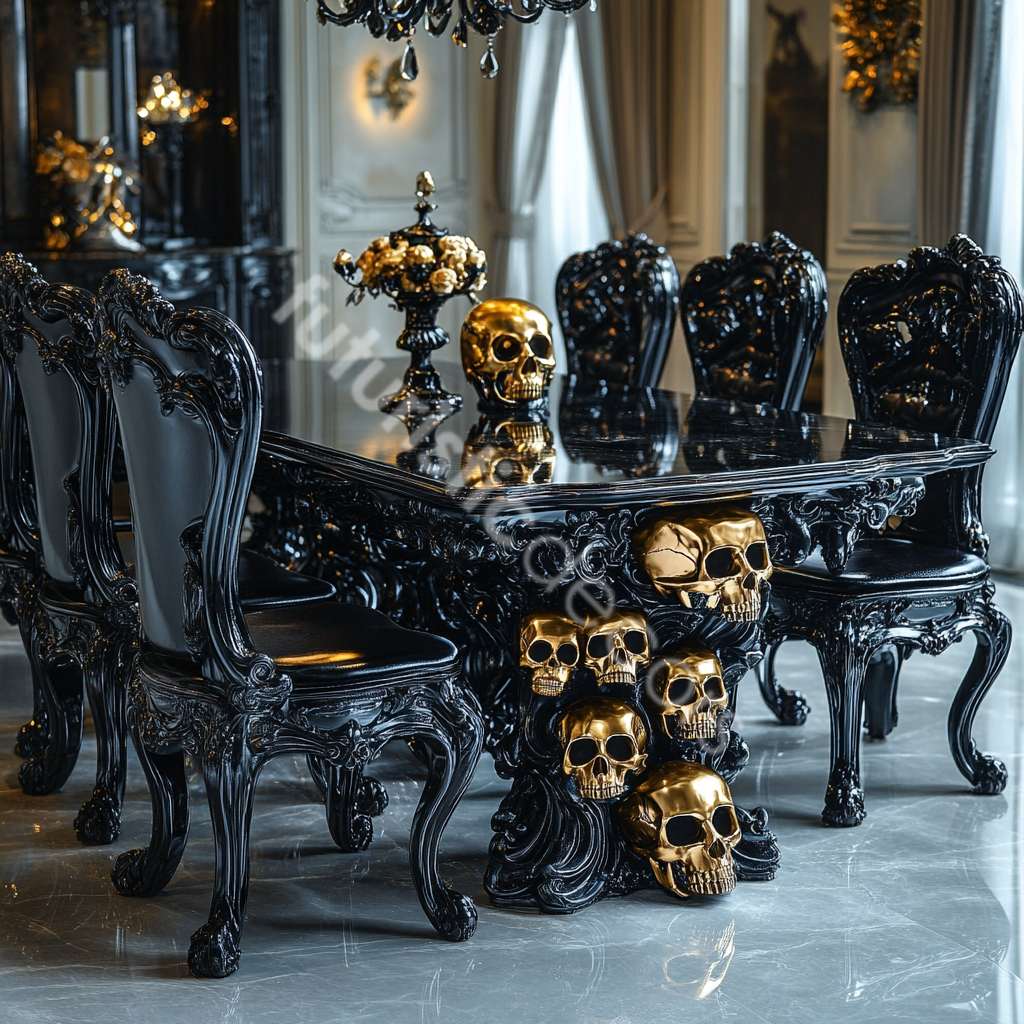
A Brief History of Skull Motifs in Design
Skulls have appeared in art and decoration for centuries, symbolizing everything from mortality and repentance to power and transformation. In the 16th and 17th centuries, memento mori art reminded viewers of life’s fragility through skull imagery, encouraging moral reflection. Fast forward to the Victorian era, when mourning jewelry often featured human hair and skull motifs, blending sorrow with ornate craftsmanship.
The 20th century saw skulls recontextualized by counterculture movements. Punk rock embraced skulls as emblems of rebellion, while Gothic subculture adopted them for their dark romanticism. Designers like Alexander McQueen later elevated skulls into haute couture, printing them on silk scarves and jewelry, thus blurring the line between macabre and mainstream elegance. Today’s Skull Dining Table stands on the shoulders of this rich history, translating centuries-old symbolism into functional furniture that feels both classic and cutting-edge.
Materials and Craftsmanship Behind Skull Dining Tables
Quality and durability hinge on thoughtful material selection and expert craftsmanship. Below is a look at the most common materials used to realize the skull motif in dining tables:
- Solid Wood (Oak, Walnut, Mahogany):
Expert woodworkers carve skull shapes directly from thick timber slabs, revealing intricate details in jawlines, eye sockets, and nasal cavities. Hand-sanded finishes accentuate the natural grain, while protective sealants guard against spills and wear. A solid wood Skull Dining Table offers organic warmth and unmatched longevity, though it may demand careful maintenance to prevent staining. - Resin and Fiberglass:
Modern mold-making techniques allow producers to cast highly detailed skull bases using durable resin blends. These tables often feature glossy or matte finishes and can be colored or embedded with metallic flakes. Resin models are lightweight relative to wood or stone, making them easier to move, but they retain heat differently and may scratch if not properly protected. - Metal (Cast Iron, Aluminum, Stainless Steel):
Metal skull tables speak to industrial or steampunk sensibilities. Foundries cast skull motifs in iron for a raw, textured look, or use aluminum and steel for sleeker, polished surfaces. Metal tables pair well with glass tops, allowing the base’s intricate details to shine through. These pieces are exceptionally sturdy, though they can feel heavy and cold to the touch. - Stone and Marble:
For an ultra-luxurious twist, designers carve skull forms from marble or local stone. The natural veining of marble adds organic patterning to each skull, ensuring no two tables are identical. Stone bases support tempered glass tops exceptionally well, but these tables tend to be the most costly and heaviest options, requiring professional installation.
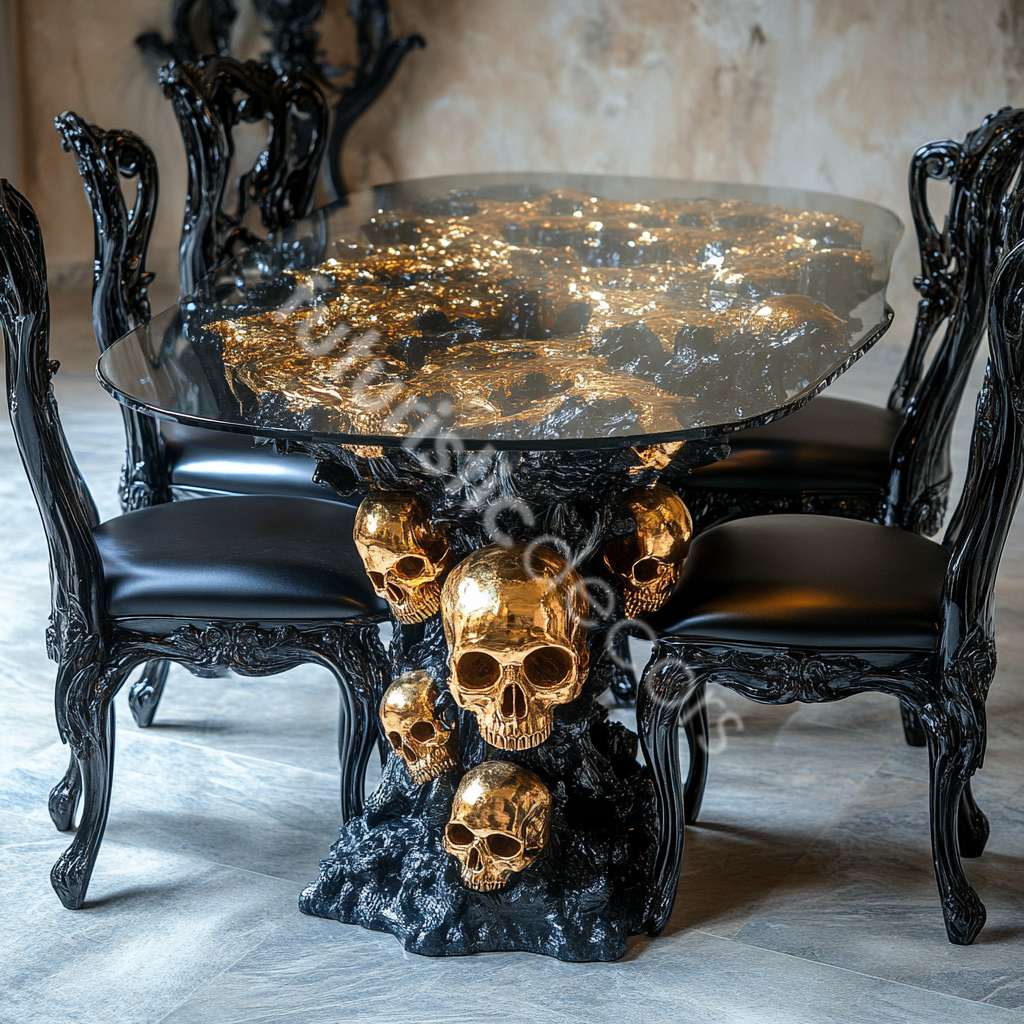
Attention to detail—from chiseling minute crevices to finishing surfaces uniformly—is paramount. When selecting a skull dining table, examine the joinery, inspect for casting seams, and verify the finish quality to ensure years of enjoyment.
Popular Styles and Variations: Skull Dining Table
Skull dining tables come in myriad designs, each catering to different tastes and décor schemes:
- Single Skull Pedestal:
A single oversized skull supports a circular or oval tabletop. This minimalist approach highlights the skull as the sole centerpiece and works beautifully in small to medium spaces. - Multiple Skulls Cluster:
A grouping of smaller skull forms arranged radially or linearly under a rectangular top creates a sculptural effect. This dynamic base adds movement and visual interest from every angle. - Abstract Skull Impression:
Rather than anatomically accurate skulls, some designers opt for stylized interpretations—smooth curves, partial outlines, or geometric cutouts. These versions hint at the motif without overt realism, fitting seamlessly into contemporary or minimalist decors. - Integrated Storage:
Combining form with function, certain tables incorporate hidden drawers or shelves within the skull base. Perfect for stashing placemats, utensils, or wine accessories, these hybrid designs maximize practicality without sacrificing drama. - Glass-Top Showcase:
Tempered glass surfaces float above the sculpted base, offering unobstructed views of the skull details. Clear tops visually expand the room and let light bounce through, softening the gothic theme.
Whether your aesthetic leans toward raw gothic or refined modern, there’s a Skull Dining Table style waiting to anchor your dining space.
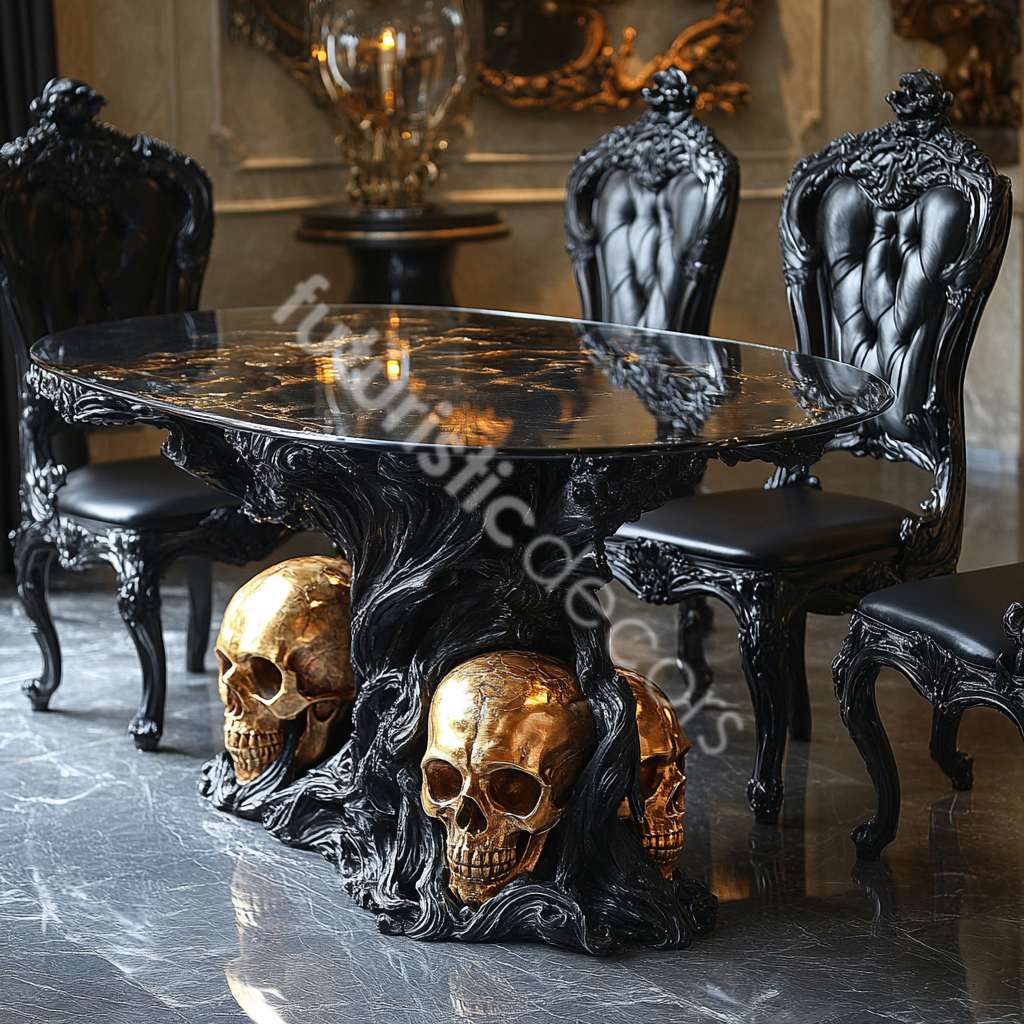
Customization and Personalization Options
One of the most exciting aspects of skull dining tables is the scope for personalization. Leading artisans and specialty brands often offer customization services:
Finish Selection:
Choose from distressed antiqued patinas, high-gloss lacquer, brushed metal, or natural wood stains. A dark cherry stain amplifies gothic warmth, while a crisp white lacquer can reinterpret the skull motif for coastal or shabby chic interiors.
Accent Materials:
Inlays of mother-of-pearl, semi-precious stones, or metal rivets can accentuate eye sockets or jawlines. Gold or copper leafing along the skull’s contours creates shimmering highlights that catch the light.
Top Shape and Material:
Beyond standard circles or rectangles, custom tabletops can be cut into irregular silhouettes or organic shapes that follow the skull base’s outline. Material options range from reclaimed wood planks to marble slabs, each imparting its signature character.
Size and Scale Adjustments:
Whether you need an intimate two-seat breakfast table or a grand twelve-person feast, skilled craftsmen can alter proportions to meet spatial requirements without losing the motif’s impact.
Lighting Integration:
Embedding discreet LED strips around the base or underneath glass tops bathes the skull in soft, atmospheric glow. You can select color-changing LEDs for customizable moods or keep it simple with warm white lighting.
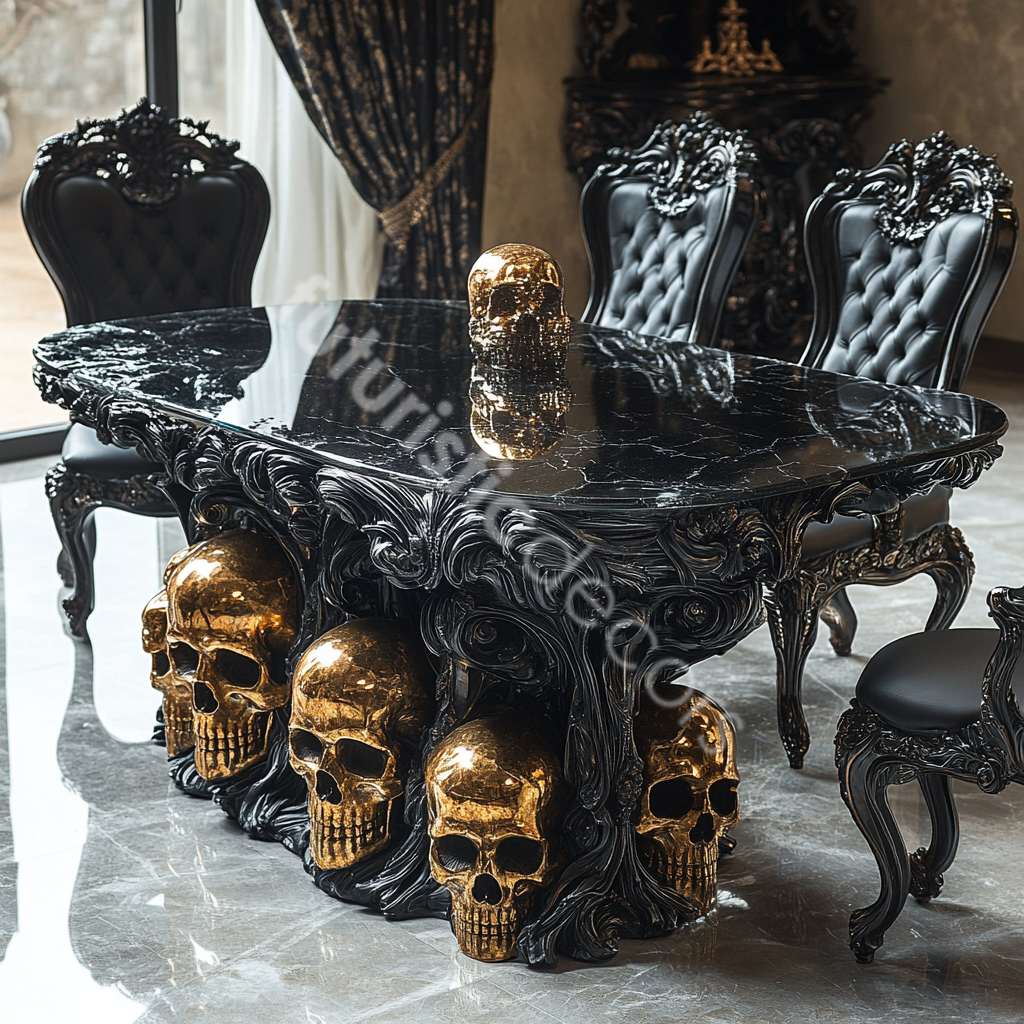
By collaborating closely with makers, you ensure that your Skull Dining Table reflects your vision down to the last detail.
Practical Considerations: Size, Seating, and Functionality
Before investing in a statement piece, it’s crucial to assess your practical needs:
Room Dimensions:
Measure your dining area carefully. Standard clearances recommend at least 36–48 inches between the table edge and walls or furniture. Oversized skull bases may require a pedestal-style top to maximize legroom.
Seating Capacity:
A 48-inch round table typically seats four comfortably, while a 72-inch rectangular top accommodates six to eight. If you host occasional large dinners, consider extension tables or bench seating that can slide beneath a single-skull base.
Table Height:
Most dining tables sit between 28 to 30 inches high. Confirm that the skull base allows enough clearance for chairs with arms, and test with your existing seating if possible.
Weight and Assembly:
Stone and metal tables can exceed 300 pounds. Ensure your floor structure supports the load and plan for professional delivery and installation. Resin and wood models tend to be more manageable but still require two people to maneuver safely.
Maintenance Requirements:
Raw wood bases need periodic waxing or oiling; resin may scratch if dragged; metal can develop patinas or rust without proper sealing. Factor these needs into your long-term living comfort.
Balancing bold design with day-to-day usability will ensure your Skull Dining Table remains both a showstopper and a reliable gathering point.

Styling Your Skull Dining Table in Your Home
Once you’ve selected the perfect table, thoughtful styling will let it shine:
Lighting Ambiance:
Position a statement chandelier or industrial pendant above the table to cast dramatic shadows across the skull base. For a more intimate vibe, install wall sconces or candelabras that play off gothic motifs.
Seating Choices:
Velvet-upholstered chairs in deep jewel tones—emerald, burgundy, or sapphire—provide sumptuous contrast against neutral walls. Leather chairs in cognac or black bring an edgy, rock ’n’ roll attitude. Mix upholstered benches on one side for a relaxed, eclectic look.
Textiles and Table Linens:
Lace or damask runners evoke Victorian elegance, while raw burlap or black linen lends a modern gothic twist. Layered tablecloths in contrasting textures add visual depth.
Centerpieces and Accessories:
Floral arrangements in sculptural urns blend softness with macabre flair. Think deep red roses, black calla lilies, or cascading greenery. Candles—tapered black or metallic—heighten drama. Display skull-adorned dinnerware or artisanal ceramics to echo the base’s motif.
Surrounding Décor:
Anchor the space with a textured accent wall—trompe-l’œil stone effect, dark velvet panels, or distressed wood. Hang antique mirrors with ornate frames, framed anatomical prints, or curated collections of curiosities to complement the table’s gothic character.
By coordinating materials, finishes, and lighting, you transform the Skull Dining Table from a standalone piece into a cohesive design narrative that resonates throughout your home.
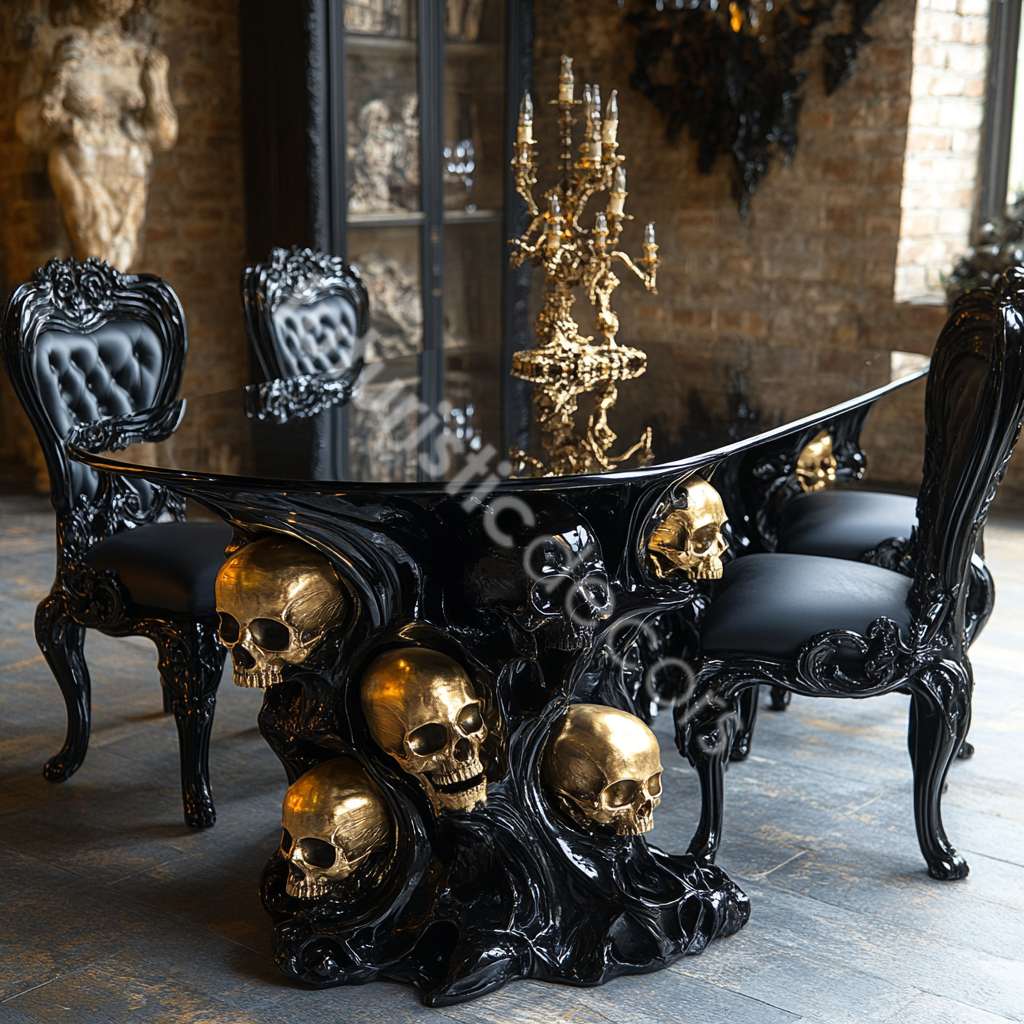
Maintenance and Care Tips: Skull Dining Table
To preserve both form and function, follow these guidelines:
Daily Cleaning:
Wipe tabletop surfaces with a soft, damp cloth. For glass tops, use a gentle glass cleaner. Avoid abrasive pads or harsh chemicals that could dull finishes or scratch resin.
Protective Measures:
Use coasters, placemats, and trivets under hot dishes or glassware to prevent stains and heat damage. Consider felt pads beneath decorative objects to avoid scratching.
Periodic Upkeep:
Wood Bases: Apply a high-quality furniture wax or oil every six months to nourish and seal the grain.
Resin Surfaces: Buff minor scratches with a non-abrasive polish designed for plastics.
Metal Finishes: Dust regularly and, if indoor humidity is high, apply a light coat of clear wax or lacquer to inhibit oxidation.
Stone/Mable: Re-seal annually with a penetrating sealant to guard against spills and staining.
Avoid Direct Sunlight:
Prolonged exposure to UV rays can fade pigments and weaken certain resins or finishes. Use window treatments or reposition pieces away from direct sunlight when possible.
By incorporating these simple routines, your Skull Dining Table will maintain its striking appearance and structural integrity for years to come.
Where to Find and How to Choose the Right Piece
A range of retailers and artisans cater to varying budgets and tastes:
- Boutique Design Studios:
Specialized workshops often accept custom commissions, offering unparalleled craftsmanship and unique materials. Expect higher price points but gain full control over design details. - Online Marketplaces:
Platforms like Etsy or specialty furniture sites feature independent makers whose pieces range from handcrafted solid wood to resin-cast models. Carefully review customer photos and seller ratings before purchasing. - High-End Retailers:
Select luxury furniture stores carry designer collaborations or limited-edition skull tables. These come backed by warranties and professional delivery but carry premium prices. - Home Decor Chains:
Some mainstream stores have embraced gothic-inspired collections, offering more affordable resin or metal skull tables. While less customizable, these pieces provide instant availability and retailer support.
Refer to buy similar products: Click here
When shopping, consider:
- Authenticity of materials (solid vs. engineered wood, genuine metal vs. plated alloys).
- Detailed close-up images showing texture, finish, and any imperfections.
- Return policies, warranties, and delivery logistics—especially for oversized or fragile items.
Armed with this information, you can confidently select a Skull Dining Table that fits your style, space, and budget.
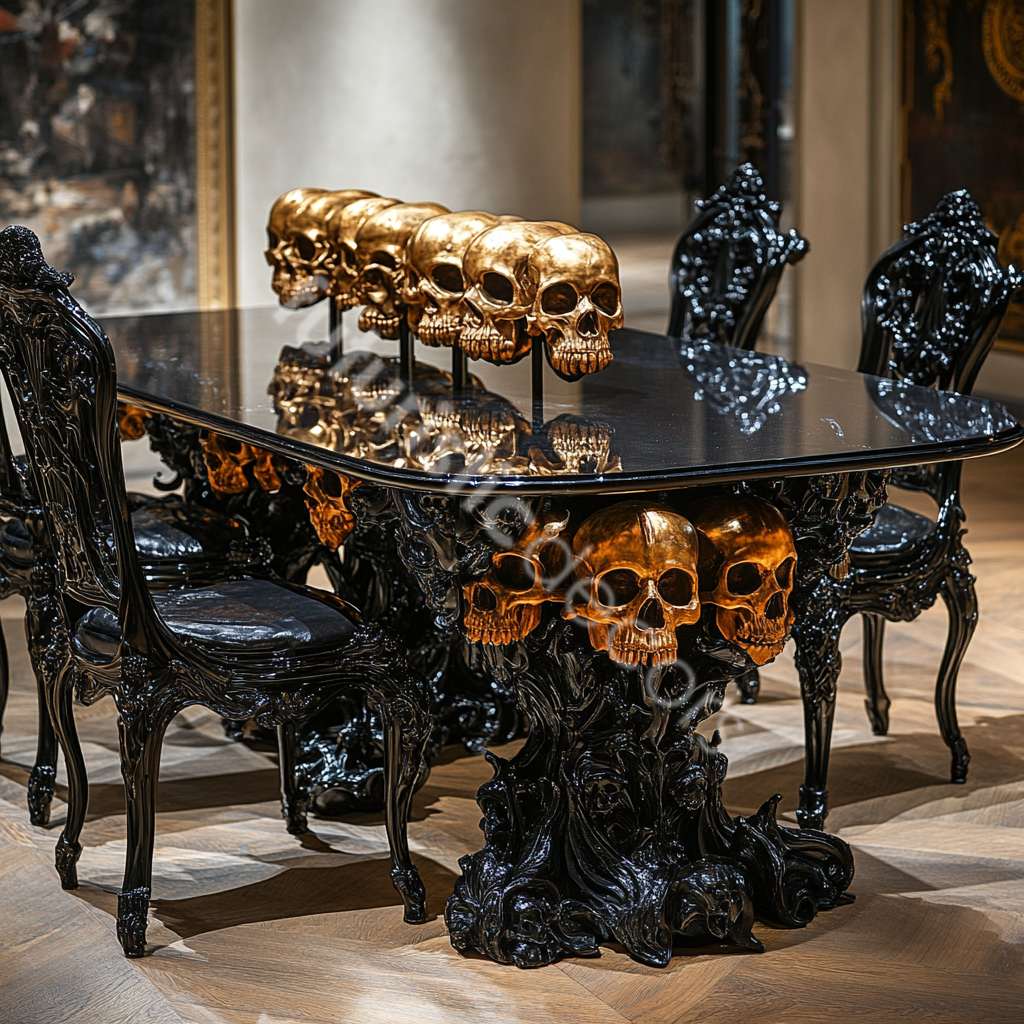
Budget-Friendly Alternatives and DIY Ideas
A full-scale custom skull table can be a significant investment. For those seeking a more accessible approach, consider these creative options:
- Skull Table Legs + DIY Top:
Purchase decorative skull-shaped table legs or pedestals online, then pair them with a ready-made tabletop from an affordable material like pine or composite wood. Seal and paint the top to match your base’s finish. - Skull Sculptures as Base Accents:
Repurpose smaller skull sculptures around a simple metal or wood frame. Secure them with epoxy adhesive, then cover with a glass or plywood top—an eclectic, upcycled statement piece on a budget. - Stencil and Paint Technique:
Transform an existing tabletop by stenciling skull patterns along the apron or center in chalk-based paint. Seal with clear polyurethane for a durable, Victorian-inspired update. - Casting Your Own Resin Skulls:
Craft hobbyist resin kits allow you to cast multiple skull forms in silicone molds. Once cured, assemble them into a base and finish with spray paint or metallic leaf. Top with reclaimed wood for a rustic-industrial fusion.
These DIY approaches let you capture gothic flair without overstretching your wallet, all while adding a personal, handcrafted touch to your dining area.
Frequently Asked Questions: Skull Dining Table
Q1: Will a skull dining table fit in a small apartment?
A1: Yes—opt for a single-skull pedestal design with a round or square top no larger than 36–42 inches. This minimizes visual bulk while still offering dramatic impact. Complement with slim-profile chairs to maximize floor space.
Q2: Are skull tables comfortable for everyday use?
A2: Absolutely. Reputable makers ensure adequate knee and foot clearance around the base. Test dimensions before purchase, and choose a pedestal with recessed contours to avoid cramped seating. Durable finishes on the tabletop protect against daily wear.
Q3: How do I balance gothic décor without making the room feel dark or heavy?
A3: Pair your Skull Dining Table with lighter textiles—sheer curtains, pale area rugs, or neutral wall colors. Incorporate greenery or fresh flowers to soften the mood. Layer lighting at multiple levels (pendants, sconces, candles) for warmth and dimension.
Q4: Can pets damage a resin skull base?
A4: Pets with sharp claws may scratch resin over time. Position the table away from high-traffic pet zones, or apply a clear protective film. Regularly trim pet nails and provide engaging toys to divert attention.
Q5: Is glass the best choice for tabletops on skull bases?
A5: Glass tops showcase the sculptural base beautifully and resist staining. However, they require frequent cleaning to remove fingerprints and can feel cold. Wood or stone tops add warmth and texture—choose based on your maintenance preference.
Q6: Where can I find sustainable or eco-friendly skull dining tables?
A6: Look for makers using reclaimed wood, recycled metal, or sustainable resin blends. Many artisans now source local materials and employ low-VOC finishes, ensuring both environmental responsibility and unique character in each piece.
Q7: How much should I budget for a quality skull dining table?
A7: Prices range widely: basic resin models start around $800–$1,200; mid-tier solid wood or metal designs cost $2,000–$4,000; high-end custom stone or designer collaborations can exceed $10,000. Factor in delivery and any assembly fees.
Conclusion: “Skull Dining Tables”
A Skull Dining Table transcends mere functionality, serving as a bold artistic statement that infuses your home with gothic chic elegance. From the storied history of skull motifs to modern materials and customizable details, these tables offer endless possibilities for self-expression. Thoughtful selection and styling ensure the piece complements your space, while simple care routines preserve its dramatic impact. Whether you invest in a commissioned work of art, select an off-the-shelf design, or craft your own budget-friendly version, a skull-inspired dining table promises to spark conversation and elevate everyday meals into immersive experiences. Embrace the allure of the macabre, and let your dining room become a gallery where form, function, and fearless style converge.














